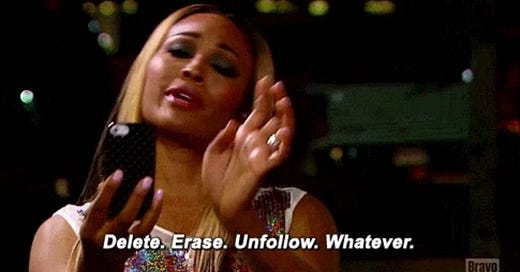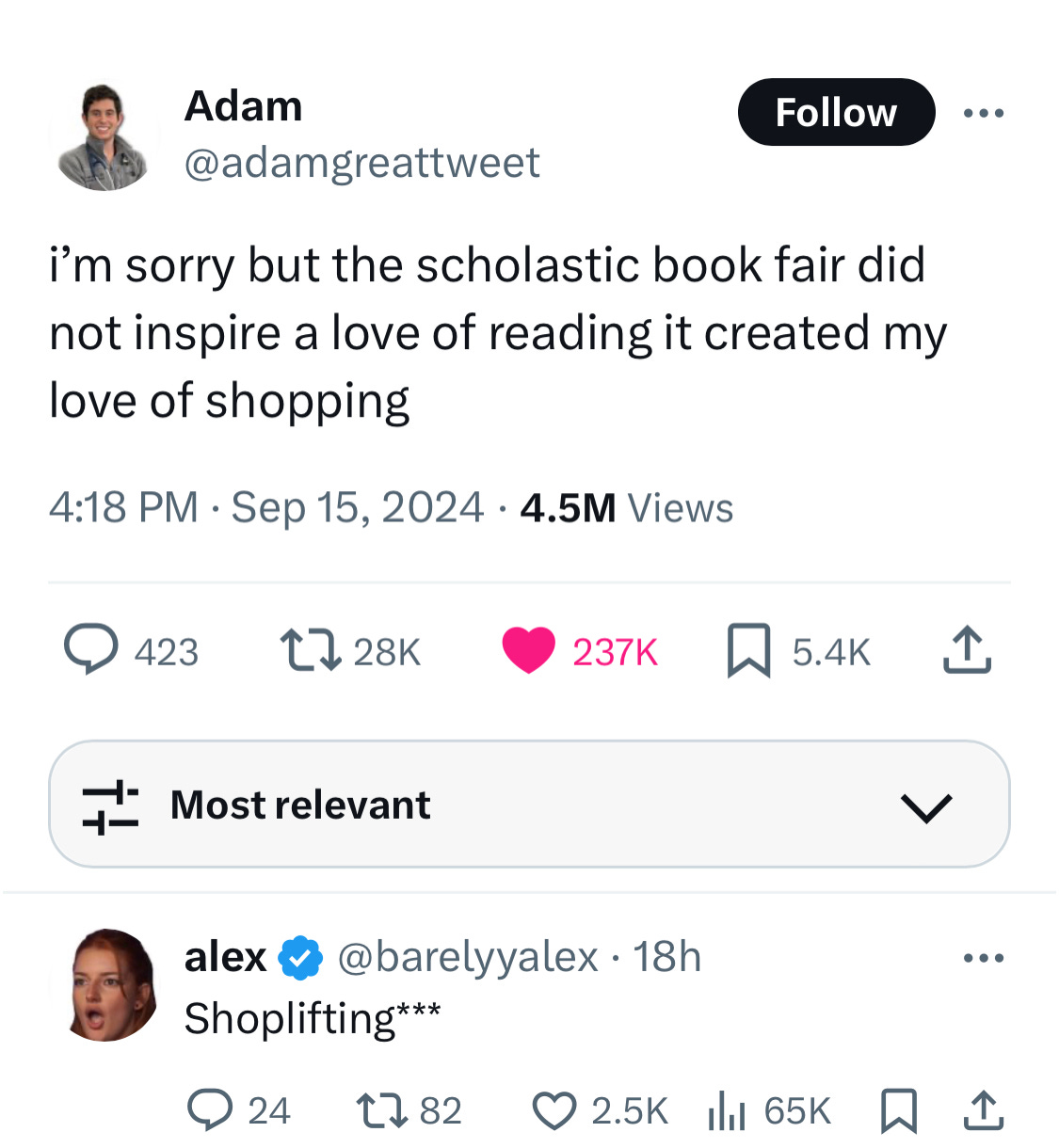Digital footprints are hard to erase. And frankly, why wouldn’t you want an archive of your thoughts, interests, and quippy remarks from the last decade? But, to echo a growing sentiment, social media has changed. Twitter and Facebook are particularly bad (with Instagram and TikTok following closely behind). The irony of TikTok naming itself as such and new documents revealing executives’ knowledge of the app’s highly addictive nature is incredibly rich.
Before I get into Substack, I want to talk about what I love/d about Twitter before it got Musky:
Shared cultural moments and live commentary. The Negro Solstice, Beychella, Aretha’s funeral, Ice Cream Gate, the slap Chris Rock deserved—there are really too many to name. Twitter’s lifeblood for a long time has been a) hatred and xenophobia and b) its powerhouse of Black users, the latter who have unbridled wit, speed, and crazy comedic timing to catapult cultural moments to the forefront in real-time. It’s unreal and so, so fun to be on Twitter during these moments.
The news IRL from the people on the ground. It is both important and horrific that people in Venezuela, Congo, Sudan, Charlottesville, Palestine, and Israel can live-tweet and share the truth of what’s happening in their regions of the world. Twitter gives us all a bloody window into the reality of the growing conflicts across our planet, realities that many of us were previously ignorant about. Where media can no longer be trusted to do the job, civilians have taken reporting into their own hands thanks to Twitter.
Character limits. Spit it out, friends, in 140 characters or less. And if you need more, practice the art of micro-storytelling with threading. Of course, now it’s all pay-to-play over there, and if you want to write a bad novel (exhibit A) or bemoan an outcome that you caused (exhibit B), you can upgrade to access more characters. At its core, though, the character limit followed the micro-consumption patterns other social media platforms established and forced us all to learn the art of brevity.
The (FREE) comedy.
The blue check. Originally, that’s how most of us could identify experts and leaders in a field—an earned blue check based on follower count, a large body of work, celebrity status, or the institutional stamp of approval.
But giving simpletons who spew utter nonsense the ability to buy blue checks turned the platform upside down.
It became really hard to tell where or who to look to for clear and interesting perspectives. And I think that was Elon’s hope, that the truth would be increasingly harder to discern. This kind of misguided platform change laid the groundwork for the faster spread of misinformation and for me, was the final nail in the coffin.
My friends are all artists, the real kind who make films and publish books for a living. Coming from a traditional background, I’ve never called myself an artist for fear of insulting the real ones. But somewhere along the path of rapidly evolving social media culture and everything from language apps to albums becoming brands, the creator category emerged.
In all my attempts at building and launching something into the world, the thread of creator was present in them. When I built my startup, I hated the technical part but loved creating and telling the story about why friendship, not romantic relationships, is the lifeblood of longevity. Science agrees, and now, a decade past those brave days of trying to be a POCIT, I can see where my strengths were. So, that brings me to Substack.
I joined Substack back in June 2020 when I wanted to revive my newsletter HiGHLiFE, which I started in 2019. At the time, there was no global news source dedicated to the goings-on of the diaspora, and I wanted to change that. Substack then was strictly devoted to writers who wanted to publish. But the interface felt challenging, I fell out of love with the idea of committing to a newsletter again, and I was between cities and relationships, so I allowed myself to get distracted.
Fast forward to 2024, a wild year for myriad reasons that I may write about later, but I’m back now with more commentary on the state of things. I also recently turned 40, so I feel like there are some new experiences headed my way that will be impossible to keep to myself. While I’ve grown to appreciate my shell and the millisecond that captured the best visual representation of my face to date (taken back in Amsterdam in 2017), I feel less comfortable being in front of the camera these days. Not because of my appearance, but more so because of the requirement to appear for relevance.
So, Substack. There’s A LOT going on here in a lot of good ways. And, I can see how without some boundaries in place this could become another time suck. But Substack exhibits some of the things I originally loved about Twitter plus some add-ons like:
Smart people sharing their stuff. While it may seem that all of the topics known to man are already covered on Substack, the platform is experiencing a kind of boom, with thousands of new newsletters (ahem, substacks) being created every day. After publishing my first post via The Lost Arts, a newsletter dedicated to things we’ve forgotten how to do as a society, I’ve come across some writers I like, highly recommended sweatpants that I plan to purchase, and a few lines that have made me laugh out loud. It feels great to connect again with thought leaders who are keen enough to craft compelling copy that I want to read, something I don’t think your average tweeter is capable of.
Curated feed by interests you follow. This is obviously a standard feature now for any kind of social platform, but I enjoy seeing a well-curated feed of things I’m interested in. While I deeply care about much of what’s happening globally and politically, I’m not yet inundated with triggering, bloody images that deplete all of my emotional energy for the day on Substack.
A way to PAY for good writing. I sincerely appreciate the fine founders of Substack integrating payments into the platform from jump. It made clear to me as a new user that Substack is a biz model built on a more equitable kind of agreement—everybody eats. Too many brands and companies do not believe in paying for good writing, and Substack helps you through payment setup (shoutout to my former employer Stripe) at onboarding, which mentally gets you thinking about building not just an audience, but a business from the beginning.
New features. There are mixed reviews about Substack's new tools for “creators,” but because I know that everyone is in business to become the next [insert whoever you think is winning], there are only two choices for survival: evolve or die. I personally plan to take a swing at the audio component of my newsletter.
The world probably doesn’t need another podcast—unless it’s mine, of course—but I appreciate that the platform is giving ambitious creators all the tools they need to turn on content experiences.
For transparency's sake, I still have my private account on Twitter and plan to sunset over the next few months. In many ways, it felt like my last “safe haven” online where I could exist with some level of anonymity but still have a front-row seat to all the social and pop culture goings-on. But I’ve reached my limit, I fear, with knowing everything all the time. It’s impacted my mental health, sleep patterns, and even some core beliefs. On that last point, I would argue that that’s a positive outcome from the platform, but this next chapter is about growth, and throwing out a lot of old bad habits and replacing them with the new.
...And Substack, girl, that’s you.







Okay so I’ve been skeptical of another writerly platform (like, isn’t this just Medium??) but as my spirit has told me to get tf off most social media for the same reasons as you (the horror, the banality, etc) I’ve been thinking about this place as, perhaps, as the place where I’ll satisfy my desperate urge to scroll though SOMETHING. This, article? newsletter? whatever was a great lil intro for me. So thank boo.